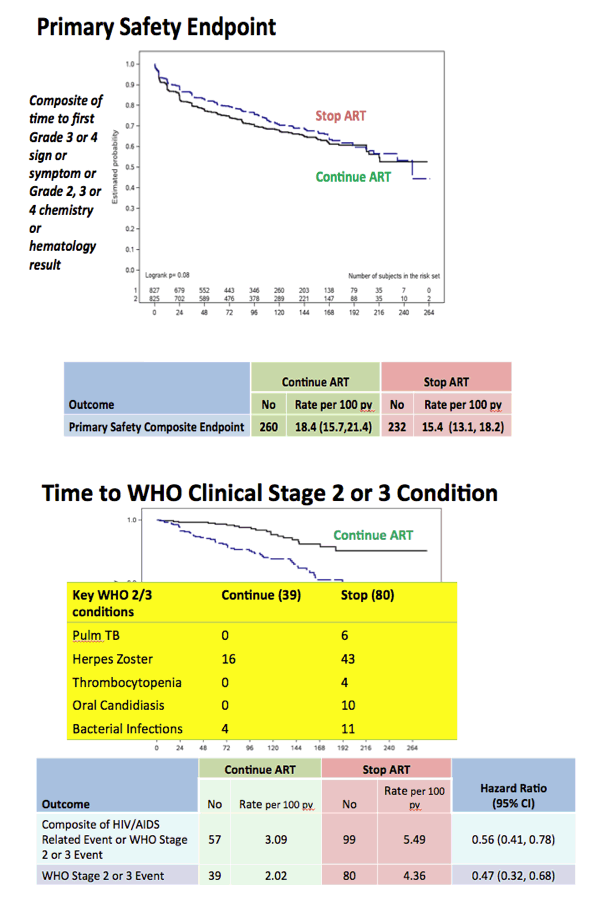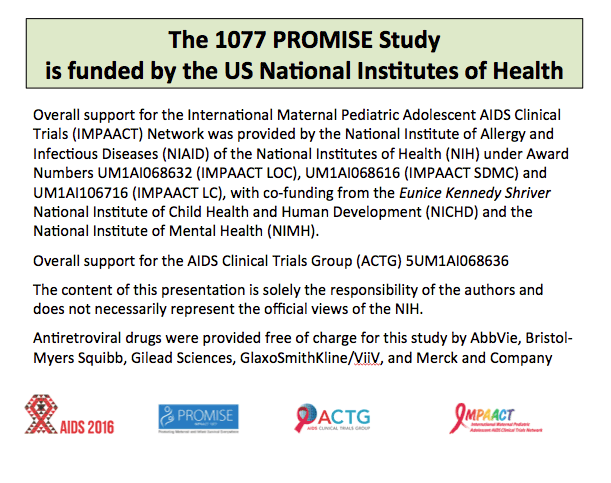 |
 |
 |
| |
Randomized trial of stopping or continuing ART among post-partum women with pre-ART CD4 >400 cells/mm3 (PROMISE 1077HS) ...." Shows Mixed Results"
|
| |
| |
"The safety and clinical benefit of continued ART observed in this randomized trial supports the use of continued ART (Option B+) for postpartum women.....Interventions to improve adherence as well as studies to examine newer regimens with a high genetic barrier to resistance are needed to insure maximal long term benefit."
------------------
Randomized Trial Shows Mixed Results With ART After Pregnancy at High CD4s
21st International AIDS Conference (AIDS 2016), July 18-22, 2016, Durban, South Africa
Mark Mascolini
Women who continued antiretroviral therapy (ART) after pregnancy with a high CD4 count did not differ from women who stopped ART in a primary endpoint combining AIDS, non-AIDS illnesses, or death after 2.3 years in the international PROMISE trial [1]. Women randomized to continue ART had half as many stage 2 or 3 World Health Organization (WHO) events than women who stopped ART, but almost one quarter of the continued-ART group had virologic failure.
WHO option B+ calls for continuing ART for life in women who start treatment during pregnancy, regardless of CD4 count [2]. Because no randomized trial assessed the health benefits of this strategy, collaborators from the US AIDS Clinical Trials Group and other organizations conducted PROMISE 1077HS at 52 sites in Argentina, Botswana, Brazil, China, Haiti, Peru, Thailand, and the United States. From January 2010 to November 2014, the investigators recruited HIV-positive postpartum women who were not breastfeeding and had a CD4 count of 400 or higher. No women had taken ART before their pregnancy and all took ART for at least 4 weeks during their current pregnancy.
The research team randomized these women to continue or stop ART within 42 days of delivery. Women who stopped ART restarted if their CD4 count fell below 350 or they had a clinical indication for ART. The study provided ART, and the preferred regimen was lopinavir/ritonavir plus tenofovir/emtricitabine. Women made follow-up visits every 12 weeks through 84 weeks after the last enrollment. The primary endpoint was time to an AIDS event (WHO stage 4), a serious cardiovascular, renal, or hepatic event, or death. Secondary endpoints included time to a WHO clinical stage 2 or 3 event. Intention-to-treat analyses involved all women randomized.
PROMISE randomized 827 women to continue ART and 825 to stop. Follow-up continued for a median of 2.31 years in the Continue group and 2.35 years in the Stop group. The Continue and Stop groups were similar in median age (27 and 28), screening CD4 count (696 and 695), pre-ART CD4 count (550 and 548), and percentage with viral load below 400 copies (91% in both groups). While 74% of the Continue group took a lopinavir/ritonavir regimen, 19% took an atazanavir/ritonavir regimen.
Numbers (and incidence) of primary composite endpoints were 4 (0.21 per 100 person-years) in the Continue-ART group and 6 (0.31 per 100 person-years) in the Stop group. The hazard ratio (HR) comparing primary event rates in the Continue versus Stop groups indicated a nonsignificant difference between groups (HR 0.68, 95% confidence interval [CI] 0.19 to 2.40).
By two other clinical measures, continuing ART proved significantly superior to stopping ART: a composite endpoint of HIV/AIDS events or WHO stage 2 or 3 events (HR 0.56, 95% CI 0.41 to 0.78) and WHO stage 2 or 3 events alone (HR 0.47, 95% CI 0.32 to 0.68). WHO stage 2 or 3 events that developed more in the Stop group than the Continue group were herpes zoster (43 versus 16), bacterial infections (11 versus 4), oral candidiasis (10 versus 0), pulmonary tuberculosis (6 versus 0), and thrombocytopenia (4 versus 0).
Time to a first grade 3 or 4 sign or symptom or grade 2 to 4 chemistry or hematology result did not differ significantly between the Continue group (18.4 per 100 person-years, 95% CI 15.7 to 21.4) and the Stop group (15.4 per 100 person-years, 95% CI 13.1 to 18.2).
Virologic failure, defined as a confirmed viral load above 1000 copies at or after 24 weeks of ART, occurred in 189 of 827 women (23%) randomized to continue ART. Resistance testing was available for 155 women with virologic failure: 103 (66%) had no evidence of resistance at failure, a finding suggesting poor adherence; 52 women (34%) did have evidence of resistance.
The PROMISE team concluded that "rates of AIDS-defining and serious non-AIDS events were lower than expected and did not differ significantly by randomized arm." But continuing ART after pregnancy in women with high CD4 counts halved the risk of WHO stage 2 or 3 events. The researchers argue that these clinical benefits and the safety of continued ART support this strategy (WHO option B+) for postpartum women. They underlined the need to improve adherence in women continuing ART after pregnancy and to assess regimens with a high genetic barrier to resistance for postpartum women.
References
1. Currier J, Britto B, Hoffman R, et al. Randomized trial of stopping or continuing ART among post-partum women with pre-ART CD4 >400 cells/mm3 (PROMISE 1077HS). 21st International AIDS Conference (AIDS 2016). July 18-22, 2016. Durban, South Africa. Abstract THAB0103LB.
2. World Health Organization. Programmatic update. Use of antiretroviral drugs for treating pregnant women and preventing HIV infection in infants. Executive summary. April 2012.
http://www.who.int/hiv/PMTCT_update.pdf









|
| |
|
 |
 |
|
|